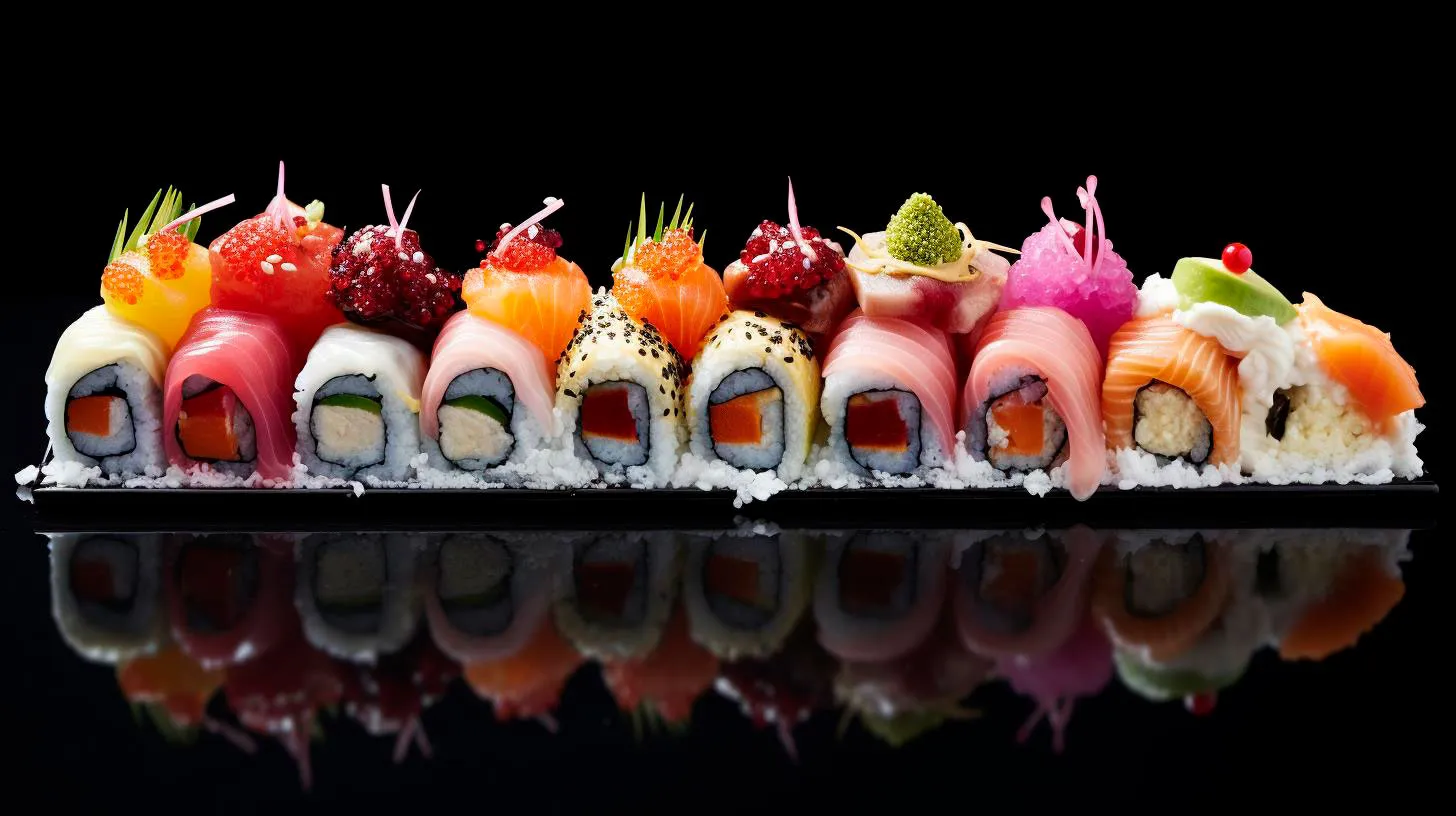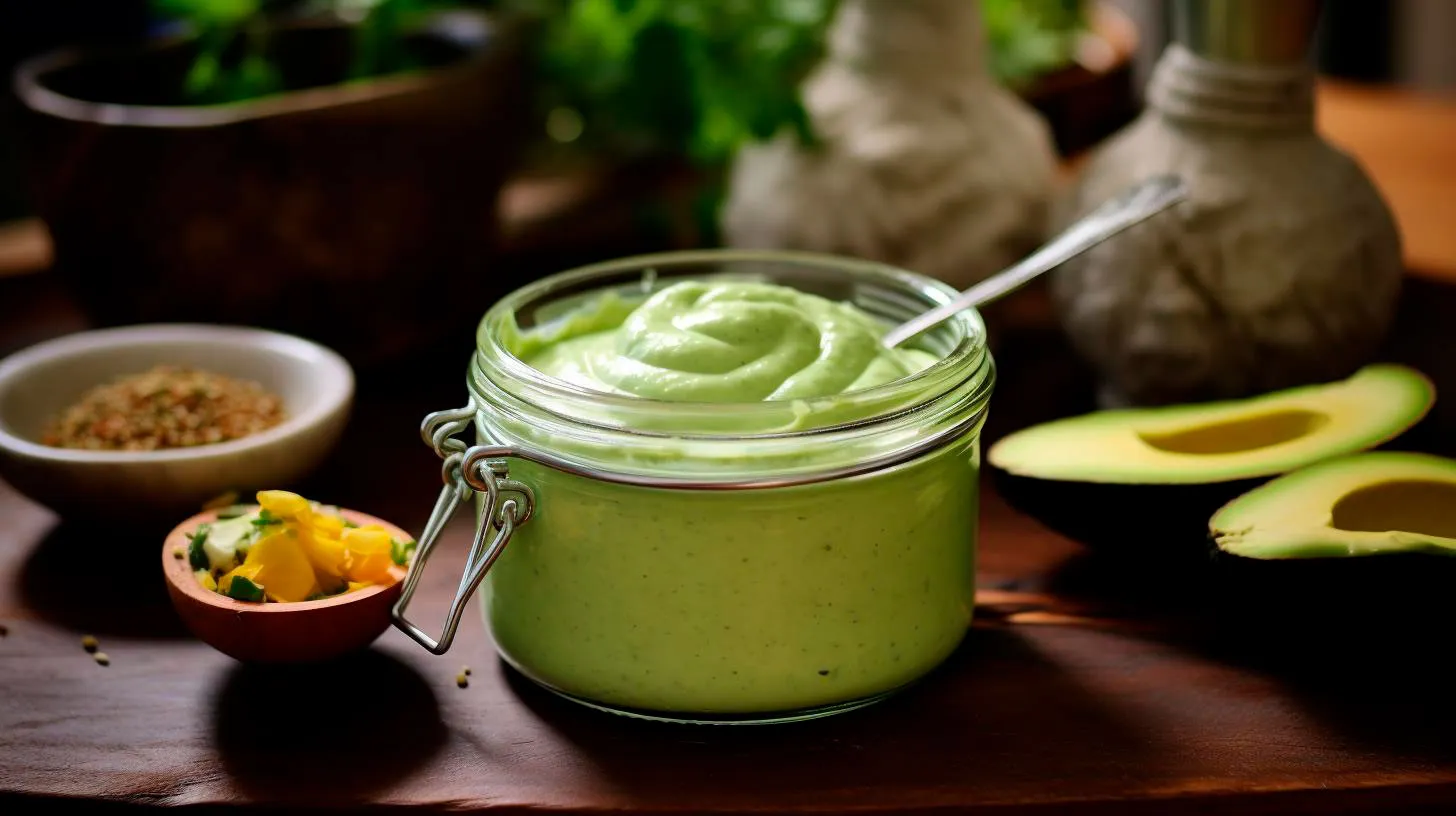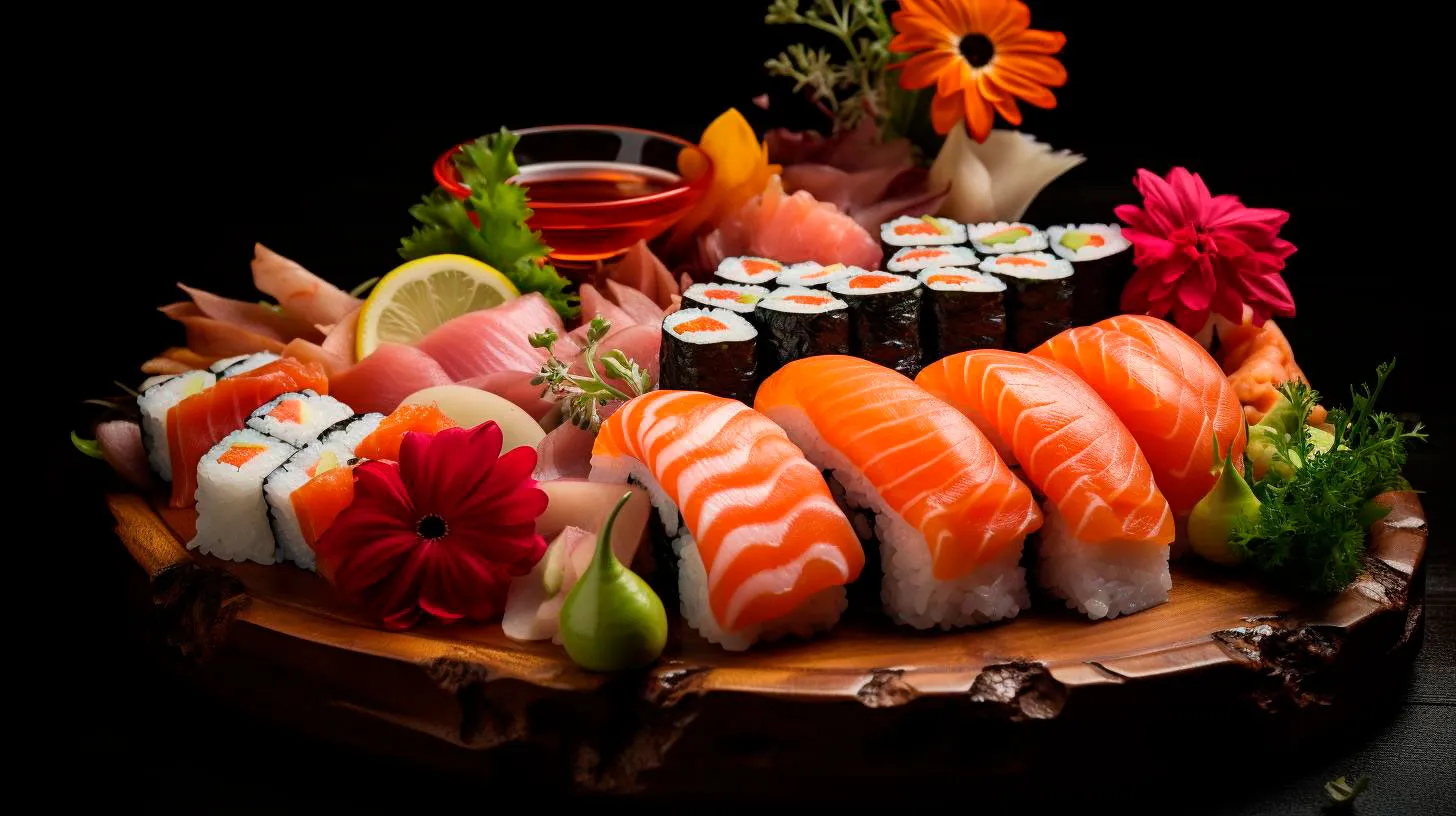The Allure of Cross-Cultural Sushi: A Delicious Journey through Global Influences
In this article, we will explore the allure of cross-cultural sushi, delving into the fusion of flavors and techniques that have made it a favorite amongst diverse populations worldwide.
A Journey from Japan to the World
Sushi, originating in Japan, was traditionally enjoyed as a quick snack or light meal. However, with globalization and the advent of travel, sushi has spread beyond Japan’s borders, taking on new forms and flavors. The assimilation of sushi into various cultures has resulted in delightful innovations that pay homage to traditional techniques while incorporating local ingredients and preferences.
Let’s take a look at some exciting cross-cultural sushi variations that have gained popularity:
1. California Roll: A Western Twist
The California Roll, revolutionizing sushi in North America, was invented in the 1960s by a Japanese chef in Los Angeles. It replaced traditional Nori (seaweed) with a sheet of avocado, making it more appealing to Western palates. This roll, often filled with cucumber, crab or imitation crab, and avocado, is an excellent entry point for sushi novices.
Key Features:
- Substitutes traditional Nori with avocado
- Features ingredients like cucumber, crab, or imitation crab
- Popular choice for sushi beginners
2. Kimbap: The Korean Adaptation
Kimbap, a Korean take on sushi, offers a flavorful twist with the inclusion of various vegetables, beef, and even kimchi. Unlike the delicate presentation of traditional sushi, Kimbap showcases its ingredients by using colorful fillings and a broader, more robust roll. This fusion of Korean and Japanese flavors creates a unique taste experience.
Key Features:
- Incorporates colorful vegetables, beef, and kimchi
- Broader and more substantial roll
- A fusion of Korean and Japanese culinary influences
3. Sushi Burritos: A Gourmet Fast Food
Sushi burritos offer a convenient and portable way to enjoy sushi with a twist. Inspired by the Mexican burrito, this cross-cultural creation wraps sushi ingredients in a larger seaweed sheet, creating a handheld delight. These oversized rolls are often filled with fresh seafood, veggies, and a variety of sauces, providing an explosion of flavors in every bite.
Key Features:
- Rolled like a burrito with a larger seaweed wrap
- Filled with fresh seafood, vegetables, and flavorful sauces
- A trendy fusion of Japanese and Mexican cuisines
The Advantages and Key Takeaways
Cross-cultural sushi not only expands culinary horizons but also offers several advantages:
1. Diversified Flavor Profiles
By incorporating local ingredients and techniques, cross-cultural sushi presents an array of flavor profiles that cater to different tastes and preferences. This diversity allows individuals to explore sushi in a way that suits their palates, making it an inclusive and accessible cuisine.
2. Increased Accessibility
The fusion of sushi with local flavors has made it more accessible to people who may have been hesitant to try traditional sushi. Innovations like sushi burritos and the California Roll have provided entry points for newcomers, gradually introducing them to the world of sushi.
3. Culinary Creativity
Cross-cultural sushi encourages culinary creativity by blending techniques, ingredients, and cultural influences. This fusion results in exciting new combinations that expand the possibilities of what sushi can be. Chefs worldwide have embraced this creativity, continually experimenting and offering unique sushi variations.
The Global Impact
The popularity of cross-cultural sushi is evident, with statistics showcasing its global impact:
- The global sushi market is estimated to reach a value of $22.5 billion by 2027, growing at a CAGR of 3.7%. (Source: Allied Market Research)
- In the United States alone, sushi consumption has grown by over 50% in the past decade. (Source: Statista)
- South Korea, known for its love of fusion cuisine, has witnessed a surge in the number of sushi restaurants across the country, embracing cross-cultural adaptations. (Source: The Korea Herald)
These statistics highlight the enduring appeal of cross-cultural sushi and its influence on global food trends.
In Conclusion
The allure of cross-cultural sushi lies in its ability to adapt and captivate diverse palates around the world. Through innovative variations like the California Roll, Kimbap, and sushi burritos, sushi has emerged as an inclusive and accessible cuisine. Embracing local flavors and techniques, cross-cultural sushi showcases the culinary creativity of chefs worldwide, allowing us to embark on a delightful journey through global influences.
How Cross-Cultural Sushi Revolutionized the Culinary World
The Evolution of Sushi
Originally, sushi was a method of preserving fish in fermented rice. It was a simple and practical technique for the Japanese to store fish as a source of nutrition. However, over time, sushi evolved into an art form, and its popularity expanded to the rest of the world.
One of the key reasons behind the sushi revolution is the accessibility of fresh ingredients. Advancements in transportation and storage techniques have made it possible to source high-quality fish and produce from all around the globe. This ensures that sushi enthusiasts can enjoy the freshest and most diverse sushi options, regardless of their location.
The Cross-Cultural Influence
As sushi made its way beyond the borders of Japan, it became subject to cross-cultural adaptation. This adaptation brought about a fusion of different culinary traditions, resulting in unique and innovative variations of sushi.
Here are some examples of how cross-cultural sushi has changed the culinary landscape:
- California Roll: This popular sushi roll was invented in Los Angeles in the 1960s as an adaptation to suit the Western palate. It features avocado, crab meat, and cucumber, and is often rolled with the seaweed on the inside instead of the outside.
- Tempura Roll: Tempura, a popular Japanese deep-fried dish, influenced the creation of the tempura roll. It combines the light and crispy texture of tempura with sushi ingredients, resulting in a delightful combination of flavors and textures.
- Spicy Tuna Roll: This sushi roll originated in the United States and has become a global favorite. The addition of spicy mayonnaise and chili sauce gives it a fiery kick, appealing to those who prefer bolder flavors.
These examples illustrate how cross-cultural influences have led to the expansion and reinvention of sushi. Each variation offers a unique experience, bringing together different flavors and textures to suit a wide range of preferences.
The Global Popularity of Sushi
The rise of cross-cultural sushi has not only transformed the culinary scene but has also contributed significantly to the global economy. The sushi industry has experienced remarkable growth with the increasing popularity of Japanese cuisine worldwide. Let’s take a look at some relevant statistics:
- In the United States alone, the sushi market was valued at $2.75 billion in 2020, with a projected growth rate of 3.1% from 2021 to 2028.
- As of 2020, Japan remained the largest consumer and exporter of fish, with sushi being a significant part of its culinary culture.
- In the United Kingdom, sushi consumption has seen a 07% increase from 2016 to 2020, indicating a growing demand for this cross-cultural delicacy.
These statistics highlight the widespread adoption and enjoyment of sushi across different countries and cultures.
Key Takeaways
The emergence of cross-cultural sushi has had a profound impact on the culinary world. Here are some key takeaways to summarize its influence:
- Cross-cultural sushi has revolutionized the traditional Japanese dish, bringing about fusion and innovation.
- Access to fresh ingredients has played a significant role in making sushi a global sensation.
- Examples like the California Roll, Tempura Roll, and Spicy Tuna Roll showcase the diverse and creative adaptations of sushi.
- The sushi industry has experienced substantial economic growth, contributing to the global economy.
- The popularity of sushi continues to grow, with increasing consumption and demand in various countries.
In conclusion, cross-cultural sushi has introduced a new era of creativity, diversity, and accessibility to the culinary world. This revolution has transformed sushi from a traditional Japanese dish to an internationally recognized and beloved cuisine. As the global demand for sushi continues to rise, we can expect even more exciting variations and innovations in the future.
Fusion Fantastic: Exploring the Best Fusion Food Trends around the World
In this article, we will take you on a culinary journey, exploring the best fusion food trends from around the globe.
1. Asian-Mexican Fusion
Combining the rich and bold flavors of Mexican cuisine with the delicate and intricate techniques of Asian cooking has given birth to a mouthwatering trend known as Asian-Mexican fusion. Whether it’s a sushi burrito or a hot and spicy Korean taco, this fusion offers the perfect balance of spicy, tangy, and umami flavors. The popularity of Asian-Mexican fusion has skyrocketed in recent years, making it a must-try for any food lover.
Key Takeaway:
- Asian-Mexican fusion combines the flavors of Mexico and Asia.
- It offers a perfect balance of spicy, tangy, and umami flavors.
- Sushi burritos and Korean tacos are popular examples of this fusion.
2. Mediterranean-Asian Fusion
The marriage of Mediterranean and Asian flavors has created an explosion of taste sensations that leave diners craving for more. From Thai-inspired Greek salads to Korean-spiced hummus, this fusion brings together the freshness of Mediterranean ingredients and the boldness of Asian spices. The result? A harmonious blend of flavors that will transport your taste buds to new culinary heights.
Key Takeaway:
- Mediterranean-Asian fusion combines freshness with boldness.
- The fusion incorporates Mediterranean ingredients with Asian spices.
- Thai-inspired Greek salads and Korean-spiced hummus are popular examples.
3. Indian-Chinese Fusion
India and China have long been recognized for their vibrant and diverse culinary traditions. The fusion of these two cuisines has given rise to a delightful combination of flavors, spices, and cooking techniques. Indo-Chinese dishes like gobi Manchurian (Cauliflower Manchurian) and chili paneer showcase the perfect amalgamation of Indian and Chinese flavors. The unique blend of spices and seasonings creates a truly unforgettable taste experience.
Key Takeaway:
- Indian-Chinese fusion combines the flavors of India and China.
- The fusion showcases a unique blend of spices and seasonings.
- Gobi Manchurian and chili paneer are popular examples of this fusion.
4. Italian-Asian Fusion
Italy’s rich culinary heritage meets the exotic flavors of Asia in the delectable world of Italian-Asian fusion. This fusion combines the comforting flavors of Italian cuisine with the bold spices and umami-packed ingredients of Asia. Dishes like miso carbonara and sushi pizza exemplify this unique blend, creating an explosion of taste that is both comforting and exciting.
Key Takeaway:
- Italian-Asian fusion combines the flavors of Italy and Asia.
- The fusion blends comforting flavors with bold spices and umami-packed ingredients.
- Miso carbonara and sushi pizza are popular examples of this fusion.
5. American-Indian Fusion
American-Indian fusion brings together the diverse cultures and flavors of two nations. This fusion embraces the boldness of American cuisine and infuses it with the aromatic spices and vibrant ingredients of Indian cooking. The fusion gives rise to unique culinary creations like butter chicken mac and cheese and Indian-spiced burgers, offering a harmonious marriage of flavors that is both comforting and adventurous.
Key Takeaway:
- American-Indian fusion combines the flavors of America and India.
- The fusion infuses American cuisine with aromatic spices and vibrant Indian ingredients.
- Butter chicken mac and cheese and Indian-spiced burgers are popular examples.
Fusion food trends continue to evolve and excite food enthusiasts worldwide. Whether it’s the creative blending of flavors from diverse cultural traditions or the incorporation of unique techniques, fusion cuisine offers a feast for both the eyes and the palate. So, be adventurous, explore these fusion food trends, and let your taste buds embark on a remarkable culinary adventure!
Unveiling the Secrets behind Cross-Cultural Sushi Creations
In this article, we will delve into the secrets behind cross-cultural sushi creations, exploring the inspiration, techniques, and benefits of these fusion rolls.
The Rise of Cross-Cultural Sushi Creations
With the increasing globalization and culinary experimentation, sushi chefs around the world have started to incorporate local ingredients and flavors into their rolls, giving birth to cross-cultural sushi creations. This trend not only adds a unique twist to traditional sushi but also allows chefs to cater to the diverse palates of their customers. By combining different culinary influences, sushi has evolved into a versatile and exciting art form.
- Blend of Traditions: Cross-cultural sushi creations combine the elegance of Japanese cuisine with the boldness of flavors from other cultures.
- Adapting to Dietary Preferences: These fusion creations cater to a wider audience, including vegetarians, vegans, and those with dietary restrictions.
- Expanded Sushi Menu: The introduction of cross-cultural sushi expands a restaurant’s menu, offering customers a diverse selection to choose from.
Techniques behind Cross-Cultural Sushi Creations
Cross-cultural sushi creations require skillful techniques to ensure that the flavors and textures complement each other harmoniously. Sushi chefs experiment with various cooking methods, ingredients, and presentation styles to create innovative rolls. Some common techniques used in these creations include:
- Ingredient Substitution: Traditional sushi ingredients are replaced with non-traditional ones, such as avocado, cream cheese, or even fruit.
- Customized Sauces: Chefs craft unique sauces that add a burst of flavor to the rolls and enhance their cross-cultural elements.
- Fusion Fillings: Sushi chefs combine different fillings like Korean BBQ, Mexican-style shrimp, or Indian curry to create unexpected flavor profiles.
The Benefits of Cross-Cultural Sushi Creations
Cross-cultural sushi creations offer several benefits for both sushi lovers and chefs alike. Let’s take a closer look at some of the advantages:
- Culinary Exploration: These fusion rolls provide an opportunity for diners to explore new flavors and experience the best of different cuisines in one bite.
- Creative Expression: Sushi chefs can unleash their creativity by combining ingredients from different culinary backgrounds, allowing them to express their unique style.
- Increased Customer Satisfaction: With a wider variety of sushi options, restaurants can attract a more diverse customer base, ensuring everyone finds something to suit their taste.
Key Takeaways
Cross-cultural sushi creations have revolutionized the sushi industry, appealing to a wider audience and offering an innovative twist to traditional sushi rolls. By blending diverse flavors and ingredients, sushi chefs create fusion masterpieces that cater to the evolving palates of diners worldwide. Some key takeaways regarding cross-cultural sushi creations include:
- These creations combine Japanese traditions with international flavors, providing a unique and exciting culinary experience.
- Techniques like ingredient substitution, customized sauces, and fusion fillings are employed to craft these cross-cultural rolls.
- Benefits include increased customer satisfaction, culinary exploration, and creative expression for chefs.
So, the next time you visit a sushi restaurant, don’t be afraid to venture beyond the traditional rolls. Let the cross-cultural sushi creations take you on a flavorful journey around the world!


